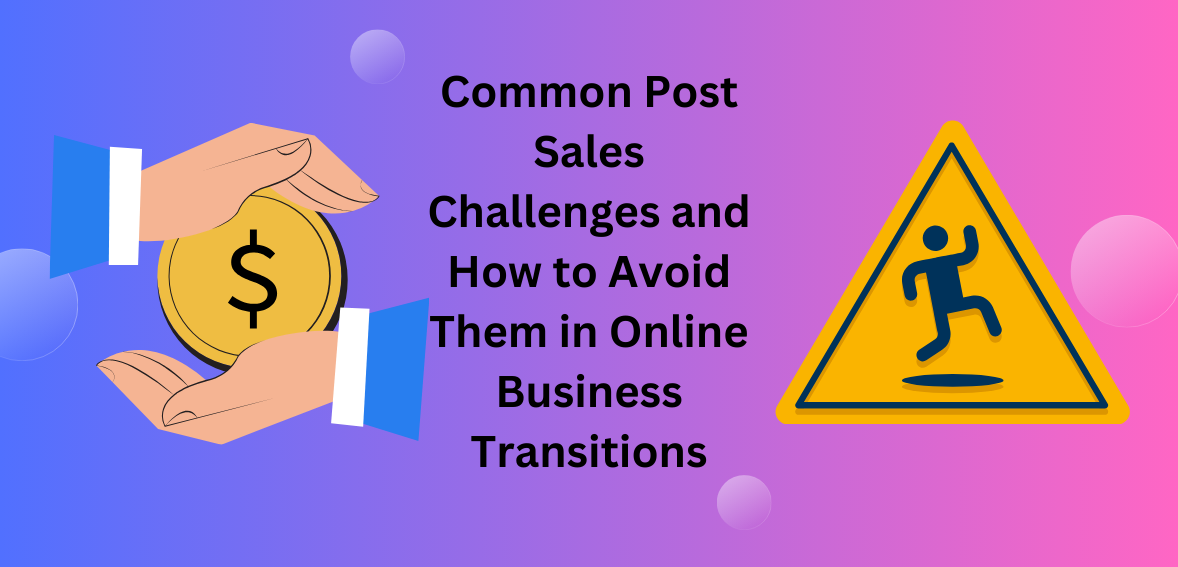In online business, selling a company is a mix of excitement and anxiety. Although much attention is given to the sale process, what follows is just as vital. Post-sale pitfalls can disrupt even the most carefully orchestrated transitions, causing financial setbacks and harming reputation. This article delves into the typical hurdles encountered during online business transitions and offers practical solutions to circumvent them.
From integration issues to customer dissatisfaction, understanding and addressing these challenges is crucial for a successful transition. By proactively tackling these obstacles, businesses can navigate the post-sale landscape more effectively, safeguarding their financial interests and preserving their standing in the market.
Introduction
Transitioning to an online business post-sale poses significant challenges. Failure to confront these hurdles can lead to enduring consequences. Thus, businesses must foresee and manage potential pitfalls to facilitate a seamless transition. From integrating new ownership to retaining customer trust, the post-sale period demands meticulous attention.
Neglecting these challenges may result in operational disruptions, financial losses, and company reputation damage. Therefore, proactive planning and strategic management are essential to navigate this critical phase successfully. By acknowledging and addressing the complexities of the post-sale process, businesses can minimize risks and position themselves for long-term success in their new landscape.
Understanding Post-Sale Pitfalls
Lack of Planning:
Post-sale failures often stem from a lack of comprehensive planning. Many businesses invest significant resources into the acquisition phase but overlook the crucial aspect of post-sale integration. Companies risk encountering numerous obstacles in the transition phase without a well-structured plan.
From operational inefficiencies to cultural clashes, a clear roadmap can amplify challenges and hinder progress. Effective planning involves assessing organizational structure, technology integration, and employee retention strategies. By proactively addressing these issues, businesses can streamline the transition process and mitigate risks associated with post-sale integration.
Communication Breakdown:
Effective communication is vital for the success of any business transition, especially during post-sale integration. However, communication breakdowns often occur due to misaligned expectations and unclear directives. Without transparent communication channels, stakeholders may feel disconnected and uninformed, leading to confusion and resistance.
Clear communication is essential for aligning all parties involved in the transition, including employees, customers, and external partners. Regular updates, town hall meetings, and open forums can facilitate dialogue and foster trust among stakeholders, thereby minimizing the risk of communication breakdowns.
Customer Dissatisfaction:
Customers may experience service disruptions during online business transitions, leading to dissatisfaction. Whether it’s delayed deliveries, changes in product offerings, or difficulty accessing support services, these disruptions can negatively impact the customer experience. Failure to promptly address customer concerns can result in loss of loyalty and negative word-of-mouth publicity, tarnishing the business’s reputation.
Companies must prioritize customer communication and support throughout the transition process to mitigate customer dissatisfaction. By proactively addressing customer concerns and ensuring continuity of service, companies can minimize the impact of the transition on customer satisfaction and preserve their reputation in the market.
Common Challenges in Online Business Transitions
Integration Issues:
Merging different systems and processes after a sale can be overwhelming. The mix of technologies and infrastructures might not align seamlessly, causing disruptions in workflow efficiency. Mismatched systems can lead to operational inefficiencies and decreased productivity, impacting the bottom line.
Addressing integration issues requires careful planning and stakeholder coordination to ensure a smooth transition. Businesses can minimize disruptions and optimize their operational effectiveness by identifying compatibility challenges early on and implementing robust integration strategies.
Data Migration Hurdles:
Transferring data from old systems to new ones presents numerous challenges. Data may be inconsistent, incomplete, or incompatible with the new platform, leading to potential loss or corruption. Moreover, data security concerns loom large during the migration process, with the risk of breaches posing significant threats to the business.
Overcoming data migration hurdles requires a meticulous approach, including thorough data cleansing, validation, and encryption measures. By investing in reliable migration tools and enlisting the expertise of data professionals, businesses can mitigate risks and ensure the integrity and security of their data throughout the transition process.
Legal and Compliance Matters:
Navigating the legal and regulatory landscape is critical to online business transitions. Compliance with industry standards and regulations is essential to avoid legal liabilities and fines that could arise from non-compliance. However, deciphering complex legal requirements and ensuring adherence can be challenging, especially across jurisdictions.
Businesses must conduct comprehensive legal, due diligence and engage legal experts early in the transition process to identify potential risks and develop mitigation strategies. By proactively addressing legal and compliance matters, businesses can minimize legal exposure and ensure a smooth and legally sound transition to new ownership or operations.
How to Avoid Post-Sale Pitfalls
Thorough Due Diligence:
Before embarking on any business transition, conducting thorough due diligence is paramount. This involves a comprehensive assessment of various aspects, such as the deal’s financial, operational, and legal considerations. By meticulously scrutinizing these areas, businesses can identify potential risks and devise proactive mitigation strategies. Financial due diligence helps evaluate the economic health and viability of the transaction, uncovering any hidden liabilities or financial irregularities that could impact the deal.
Operational due diligence focuses on assessing the operational aspects of the business, including its processes, systems, and infrastructure, to ensure compatibility and identify areas for improvement. Legal due diligence involves reviewing contracts, agreements, and regulatory compliance to mitigate legal risks and ensure a smooth transition.
Effective Communication Strategies:
Clear and transparent communication is essential for fostering trust and a successful transition. Establishing clear lines of communication among all stakeholders, including employees, customers, and partners, helps manage expectations and address concerns effectively. Regular updates, town hall meetings, and open forums allow stakeholders to voice their concerns, ask questions, and receive timely updates on the transition process. By fostering an environment of transparency and open communication, businesses can mitigate misunderstandings, build trust, and navigate the transition process more smoothly.
Prioritize Customer Satisfaction:
During online business transitions, prioritizing customer satisfaction is crucial for maintaining loyalty and goodwill. Proactively addressing customer concerns, ensuring continuity of service, and providing exceptional support can help mitigate the risk of customer churn. By putting the needs of customers front and center, businesses can strengthen relationships, build loyalty, and minimize the impact of the transition on customer satisfaction.
Smooth Transition Planning:
A comprehensive transition plan is essential for minimizing disruptions and ensuring a seamless post-sale experience. This involves meticulous planning and coordination, including IT systems integration, employee onboarding, and customer communication.
By identifying potential challenges, allocating resources effectively, and implementing proactive mitigation strategies, businesses can navigate the transition process more efficiently and minimize the risk of disruptions or delays. A well-executed transition plan ensures operations continuity and enhances the business transition’s overall success.
Conclusion
Successfully navigating the post-sale landscape during online business transitions demands meticulous planning and execution. Businesses must comprehend the typical challenges and proactively devise strategies to address them. Companies can mitigate risks and facilitate a smooth transition by recognizing common pitfalls such as integration issues, data migration hurdles, and legal complexities.
Through thorough preparation and strategic implementation, businesses can ensure continuity of operations, minimize disruptions, and enhance the overall success of the transition process. A proactive approach enables companies to navigate uncertainties effectively, safeguard their interests, and capitalize on opportunities for growth in the post-sale phase.





















